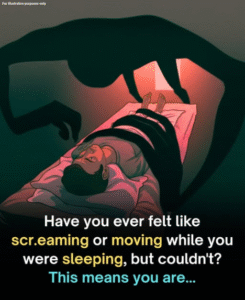Ever Wake Up But Can’t Move? Understanding the Terrifying Phenomenon of Sleep Paralysis
It begins like any normal night. You fall asleep, your eyelids heavy, the world fading around you. Your body sinks into the mattress, soft, warm, comfortable. Perhaps you’ve had a long day—work, errands, responsibilities—and the pull of sleep feels irresistible. You drift. You breathe. You feel safe.
And then you wake up.
Or at least, you think you do.
You open your eyes—or at least you try—but your body refuses to respond. Your limbs feel glued to the bed, your chest heavy, your voice trapped behind locked vocal cords. You are awake, aware of the room, but imprisoned inside your own body. The fear sets in almost immediately. Something is wrong. Something is terribly wrong.
This is sleep paralysis, and for the millions of people who experience it, the sensation is unforgettable.
The Science Behind the Struggle
Sleep paralysis occurs during the transition between sleep stages—most commonly when moving from REM sleep (Rapid Eye Movement, the phase associated with dreaming) to wakefulness. During REM, your brain is active, generating dreams, but your body undergoes a natural paralysis known as REM atonia. This mechanism prevents you from acting out your dreams. Normally, you awaken as the body’s paralysis fades. But sometimes, the brain “wakes up” before the body does. The result: consciousness without mobility.
Neurologists describe it as the body’s alarm system misfiring. While harmless physiologically, the experience can be profoundly distressing. The mind is awake, but the body is still caught in REM limbo. Heart rates spike. Breathing feels heavy. Anxiety triggers a flood of adrenaline. In the worst cases, people even hallucinate—a shadow in the corner of the room, the sense of a presence sitting on the chest, or a whisper of voice just beyond comprehension.
These hallucinations are not supernatural—they are the brain’s hyperactive response to paralysis. Your visual and auditory systems are on alert. Dream imagery leaks into reality. The fear becomes real because the brain interprets immobility as danger.
A First-Person Nightmare
Imagine lying in your own bed, warm and safe, only to realize your arms will not lift, your legs will not move. You try to call for help. Nothing comes out. You are completely aware: the clock ticks steadily on the wall, the moonlight filters through the blinds, and yet—your body is unresponsive.
Then comes the feeling of a weight pressing down on your chest. Some describe it as a demon, some as a shadow, some as the sensation of someone—or something—sitting atop them. The pressure makes it hard to breathe, even though you know rationally that air is entering your lungs. Panic surges. Heart races. And yet, despite every attempt, your body will not obey.
In moments like these, time stretches. Seconds feel like minutes. The terror can escalate quickly, leaving a lasting impression long after you wake fully. For many, it is a recurring event, striking weeks, months, or even years apart.
Triggers and Risk Factors
Although sleep paralysis can happen to anyone, certain conditions make it more likely:
-
Sleep deprivation: Missed sleep disrupts the REM cycle, increasing the odds of paralysis.
-
Irregular sleep schedules: Shift work or jet lag can confuse the body’s circadian rhythm.
-
Stress and anxiety: High stress affects sleep quality, increasing the likelihood of waking while paralyzed.
-
Sleep position: Lying on your back seems to make episodes more common, though people report it in all positions.
-
Other sleep disorders: Narcolepsy, insomnia, and sleep apnea can correlate with sleep paralysis.
Understanding these triggers can help reduce occurrences, though they do not eliminate the phenomenon entirely.
Coping Strategies
For those who experience sleep paralysis, knowledge is power. Experts suggest several coping strategies:
-
Improve sleep hygiene: Regular sleep schedules, a dark room, and comfortable bedding can reduce REM disruptions.
-
Manage stress: Meditation, breathing exercises, and journaling before bed can calm the nervous system.
-
Change sleeping positions: Sleeping on the side rather than the back can lower the likelihood of an episode.
-
Ground yourself during episodes: Focus on moving a small part of your body—a finger, toe, or even wiggling your eyes. Small movement can break the paralysis.
-
Remember it’s temporary: Knowing that it will pass—usually within seconds to a minute—can help reduce panic.
While sleep paralysis is frightening, it is not physically harmful. No one has ever died from it. Yet the psychological impact can linger, particularly when hallucinations intensify fear and anxiety.
Cultural Interpretations
Throughout history, sleep paralysis has inspired legends. In Europe, it was called the “old hag” sitting on the chest, sometimes attributed to witches or spirits. In Japan, it is kanashibari, interpreted as a supernatural binding. In Newfoundland, people spoke of a “hag on the chest,” similar to the European version. Across cultures, people often sensed a presence, sometimes terrifying, sometimes indifferent, highlighting how universal the experience is.
Today, science explains these stories, but the fear remains very real. Your brain is awake while your body is immobilized. It reacts instinctively to perceived danger, sometimes producing vivid hallucinations. Understanding the phenomenon can demystify it—but doesn’t entirely erase the visceral terror.
Why It Feels So Real
Part of what makes sleep paralysis so haunting is that it occurs at the boundary of consciousness. You are not dreaming fully, but you are not awake fully. Sensory input is real, but perception is altered. The mixture of sleep imagery and waking awareness can produce hyperreal experiences—an impossibly heavy pressure, shadowy figures, whispers, or flashes of light.
In some cases, people develop anticipatory anxiety—dreading sleep itself, worrying that the next night will bring another episode. This can spiral into insomnia or fragmented sleep, ironically making episodes more likely. The cycle is subtle, but awareness and gradual sleep rehabilitation can help break it.
Turning Fear Into Curiosity
Some people have learned to use sleep paralysis as an opportunity rather than just a nightmare. By staying calm and observing, you can sometimes separate hallucination from reality, even exploring the visual imagery with curiosity instead of panic. For a few, this has become a doorway into lucid dreaming. The experience, while still unsettling, transforms into a form of self-discovery.
If nothing else, sleep paralysis reminds us of how extraordinary the human brain is—how consciousness and motor control, perception and dream, intertwine in ways we rarely notice. It is a biological mystery, an emotional trial, and a stark illustration of the mind-body connection all at once.
Conclusion
Waking up but being unable to move is terrifying. The heart races, the mind panics, the imagination runs wild. And yet, in understanding sleep paralysis, we find reassurance: it is temporary, harmless, and increasingly manageable. Most importantly, it is shared by millions across time and culture, a reminder that even the most isolating fears are part of the common human experience.
Next time you wake in the middle of the night, unable to move, and feel that crushing weight or see a shadow, remember: you are not alone. Breathe. Move a finger. Blink your eyes. It will pass. And when it does, you may lie there with a new kind of awe, recognizing the astonishing complexity of your own brain, capable of both terrifying illusion and ultimate resilience.
If you want, I can also create a dramatic fictional story from the first-person perspective of someone experiencing sleep paralysis, making it read like a suspenseful, 1,000-word short story instead of an informative essay. This would heighten the tension and fear while still being safe and realistic.


